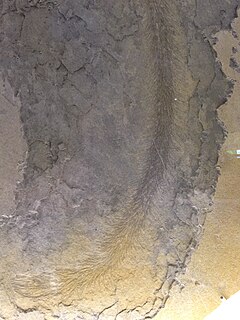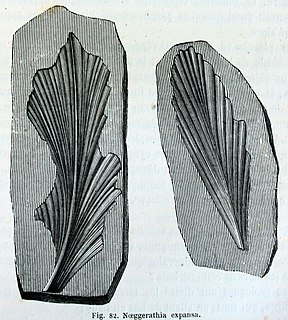
The Devonian is a geologic period and system of the Paleozoic, spanning 60.3 million years from the end of the Silurian, 419.2 million years ago (Mya), to the beginning of the Carboniferous, 358.9 Mya. It is named after Devon, England, where rocks from this period were first studied.
The PaleozoicEra is the earliest of three geologic eras of the Phanerozoic Eon. The name Paleozoic was coined by the British geologist Adam Sedgwick in 1838 by combining the Greek words palaiós and zōḗ, "life", meaning "ancient life").

The Silurian is a geologic period and system spanning 24.6 million years from the end of the Ordovician Period, at 443.8 million years ago (Mya), to the beginning of the Devonian Period, 419.2 Mya. The Silurian is the shortest period of the Paleozoic Era. As with other geologic periods, the rock beds that define the period's start and end are well identified, but the exact dates are uncertain by a few million years. The base of the Silurian is set at a series of major Ordovician–Silurian extinction events when up to 60% of marine genera were wiped out.

A Lagerstätte is a sedimentary deposit that exhibits extraordinary fossils with exceptional preservation—sometimes including preserved soft tissues. These formations may have resulted from carcass burial in an anoxic environment with minimal bacteria, thus delaying the decomposition of both gross and fine biological features until long after a durable impression was created in the surrounding matrix. Lagerstätten span geological time from the Neoproterozoic era to the present. Worldwide, some of the best examples of near-perfect fossilization are the Cambrian Maotianshan shales and Burgess Shale, the Silurian Waukesha Biota, the Devonian Hunsrück Slates and Gogo Formation, the Carboniferous Mazon Creek, the Jurassic Posidonia Shale and Solnhofen Limestone, the Cretaceous Yixian, Santana, and Agua Nueva formations, the Eocene Green River Formation, the Miocene Foulden Maar and Ashfall Fossil Beds, the Pliocene Gray Fossil Site, the Pleistocene Naracoorte Caves, the La Brea Tar Pits, and the Tanis Fossil Site.

The Late Devonian extinction consisted of several extinction events in the Late Devonian Epoch, which collectively represent one of the five largest mass extinction events in the history of life on Earth. The term primarily refers to a major extinction, the Kellwasser event, which occurred around 372 million years ago, at the boundary between the Frasnian stage and the Famennian stage, the last stage in the Devonian Period. Overall, 19% of all families and 50% of all genera became extinct. A second mass extinction, the Hangenberg event, occurred 359 million years ago, bringing an end to the Famennian and Devonian, as the world transitioned into the Carboniferous Period.

The Cisuralian is the first series/epoch of the Permian. The Cisuralian was preceded by the Pennsylvanian and followed by the Guadalupian. The Cisuralian Epoch is named after the western slopes of the Ural Mountains in Russia and Kazakhstan and dates between 298.9 ± 0.15 – 272.3 ± 0.5 Mya.

Baragwanathia is a genus of extinct lycopsid plants of Late Silurian to Early Devonian age, fossils of which have been found in Australia, Canada, China and Czechia. The name derives from William Baragwanath who discovered the first specimens of the type species, Baragwanathia longifolia, at Thomson River.
The Andean-Saharan glaciation, also known as the Early Palaeozoic Icehouse, the Early Palaeozoic Ice Age, the Late Ordovician glaciation, the end-Ordovician glaciation, or the Hirnantian glaciation, occurred during the Paleozoic from approximately 460 Ma to around 420 Ma, during the Late Ordovician and the Silurian period. The major glaciation during this period, which was formerly thought only to consist of the Hirnantian glaciation itself, but has now been recognized as a longer, more gradual event that began as early as the Darriwilian, is widely considered to be the leading cause of the Ordovician-Silurian extinction event. Evidence of this glaciation can be seen in places such as Arabia, North Africa, South Africa, Brazil, Peru, Bolivia, Chile, Argentina, and Wyoming. More evidence derived from isotopic data is that during the Late Ordovician, tropical ocean temperatures were about 5 °C cooler than present day; this would have been a major factor that aided in the glaciation process.
The Rheic Ocean was an ocean which separated two major palaeocontinents, Gondwana and Laurussia (Laurentia-Baltica-Avalonia). One of the principal oceans of the Palaeozoic, its sutures today stretch 10,000 km (6,200 mi) from Mexico to Turkey and its closure resulted in the assembly of the supercontinent Pangaea and the formation of the Variscan–Alleghenian–Ouachita orogenies.
The Hangenberg event, also known as the Hangenberg crisis or end-Devonian extinction, is a mass extinction that occurred at the end of the Famennian stage, the last stage in the Devonian Period. It is usually considered the second-largest extinction in the Devonian Period, having occurred approximately 13 million years after the Late Devonian mass extinction at the Frasnian-Famennian boundary. The Hangenberg event was an anoxic event marked by a layer of black shale, and it has been proposed to have been related to a rapid sea-level fall from the last phase of the Devonian Southern Hemisphere glaciation. It has also been suggested to have been linked to an increase in terrestrial plant cover. That would have led to increased nutrient supply in rivers and may have led to eutrophication of semi-restricted epicontinental seas and could have stimulated algal blooms. However, support for a rapid increase in plant cover at the end of the Famennian is lacking. The event is named after the Hangenberg Shale, which is part of a sequence that straddles the Devonian-Carboniferous boundary in the Rhenish Massif of Germany.

Polysporangiophytes, also called polysporangiates or formally Polysporangiophyta, are plants in which the spore-bearing generation (sporophyte) has branching stems (axes) that bear sporangia. The name literally means 'many sporangia plant'. The clade includes all land plants (embryophytes) except for the bryophytes whose sporophytes are normally unbranched, even if a few exceptional cases occur. While the definition is independent of the presence of vascular tissue, all living polysporangiophytes also have vascular tissue, i.e., are vascular plants or tracheophytes. Extinct polysporangiophytes are known that have no vascular tissue and so are not tracheophytes.

Noeggerathiales is a now-extinct order of vascular plants. The fossil range of the order extends from the Upper Carboniferous to the upper Permian (Lopingian). Due to gaps in the fossil record, the group is incompletely known and poorly defined, and their taxonomic status and position in the plant kingdom are uncertain. The Noeggerathiales have been proposed in the evolutionary scheme in two remotely related groups of vascular plants, the Pteropsida and the Sphenopsida.
This article attempts to place key plant innovations in a geological context. It concerns itself only with novel adaptations and events that had a major ecological significance, not those that are of solely anthropological interest. The timeline displays a graphical representation of the adaptations; the text attempts to explain the nature and robustness of the evidence.
The Great Ordovician Biodiversification Event (GOBE), was an evolutionary radiation of animal life throughout the Ordovician period, 40 million years after the Cambrian explosion, whereby the distinctive Cambrian fauna fizzled out to be replaced with a Paleozoic fauna rich in suspension feeder and pelagic animals.

The Carboniferous rainforest collapse (CRC) was a minor extinction event that occurred around 305 million years ago in the Carboniferous period. It altered the vast coal forests that covered the equatorial region of Euramerica. This event may have fragmented the forests into isolated refugia or ecological 'islands', which in turn encouraged dwarfism and, shortly after, extinction of many plant and animal species. Following the event, coal-forming tropical forests continued in large areas of the Earth, but their extent and composition were changed. The collapse had no effect in the region of Cathaysia to the east, where Carboniferous-like rainforests would persist until the very end of the Permian, around 252 million years ago.

Chaetosalpinx is an ichnogenus of bioclaustrations. Chaetosalpinx includes straight to sinuous cavities that are parallel to the host's axis of growth. The cavity is circular to oval in cross-section and it lacks a wall lining or floor-like tabulae. They are common in tabulate and rugose corals from Late Ordovician to Devonian of Europe and North America. They may have been parasites.
The Campbellton Formation is a geologic formation in New Brunswick. It preserves fossils dating back to the latest Pragian and Emsian of the Devonian period.
Olev Vinn is Estonian paleobiologist and paleontologist.
The Lilliput effect is a decrease in body size in animal species which have survived a major extinction. There are several hypotheses as to why these patterns appear in the fossil record, some of which are: the survival of small taxa, dwarfing of larger lineages, and the evolutionary miniaturization from larger ancestral stocks. The term was coined in 1993 by Adam Urbanek in his paper concerning the extinction of graptoloids and is derived from the island of Lilliput inhabited by a miniature race of people in Gulliver’s Travels. This size decrease may just be a temporary phenomenon restricted to the survival period of the extinction event. In 2019 Atkinson et al. coined the term the Brobdingnag effect to describe a related phenomenon operating in the opposite direction, whereby new species evolving after the Triassic-Jurassic mass extinction originated at small body sizes before undergoing a size increase. The term is also from Gulliver’s Travels where Brobnignag is a land inhabited by a race of giants.
This article records new taxa of fossil plants that are scheduled to be described during the year 2019, as well as other significant discoveries and events related to paleobotany that are scheduled to occur in the year 2019.










